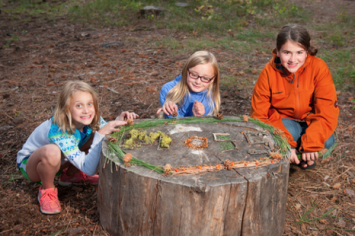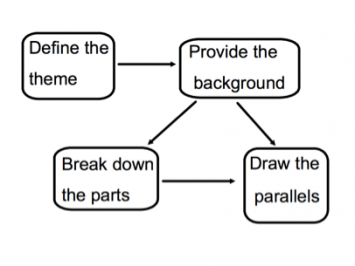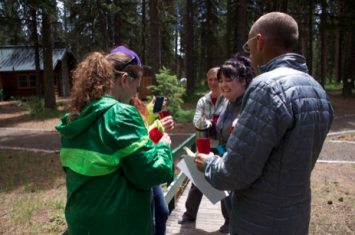Schon et al JSE Vol 8 Jan2015 PDF Ready (1) [2]
Abstract: As scientific research evolves information in (K-12) curriculum can quickly become outdated. New research can greatly change the way we teach about science topics and the content we want students to understand. Educators, both formal and informal, can enrich their science curriculum by pulling from current research. Navigating the complexities and unanswered questions alongside scientists can provide a platform for discussion and insight into the nature of science and research that many students are not aware of, providing both a unique experience and valuable lesson on problem solving. Using lessons recently created in tandem with current aviation biofuels project, this article demonstrates the steps educators can take to use ongoing research to create lessons for their own audiences. As often noted in media and current events, finding a reliable, abundant, and sustainable source of transportation fuel is a high priority. One current research effort is being led by the U.S. Department of Agriculture–funded Northwest Advanced Renewables Alliance (NARA), which combines research efforts from industry and educational institutions to build a renewable supply chain for aviation biofuel. This article highlights steps suggested for educators to break down current research to create lessons for their audiences through an explanation of lessons that were developed using NARA research as a foundation. These steps include: Define the theme, Provide the background, Break down the parts, and Draw the parallels.
Keywords: renewable energy, biofuels, bio jet fuel, science education
Teaching science can be both exciting and exhausting when it comes to staying current with research and discoveries. As science research evolves information in science curriculum can quickly become outdated. New research can greatly change the way we teach about science topics and the content we want students to understand. The dynamic nature of science research itself can provide a rich context for students to learn from, both in process and content. But how can educators break down the science behind the research developments into digestible lessons for their students? How can educators utilize the process and capitalize on the incomplete answers new research provides? And when does an educator find the time to do this?
Educators, both formal and informal, can enrich their science curriculum by pulling from current research. Navigating the complexities and unanswered questions elicited from the research can provide a platform for discussion and insight into the nature of science and research that many students are not aware of, providing both a unique experience and a valuable lesson on problem solving. However, educators often lack the time needed to really delve into new research. Citizen science and other programs for bringing science to “citizens” and back have been well developed, but there are fewer that specifically address how educators can engage with cutting edge research when an established program does not exist. This article suggests basic steps educators can take to use current research to create lessons for their audiences while highlighting lessons created from current efforts to research and develop aviation biofuel in the Pacific Northwest. By describing this process, we hope to contribute to a growing interest in “closing the gap” in the pipeline of information coming from researchers to classrooms.
Importance & value of using current research in the classroom
The addition of current science research in the classroom can stimulate students’ imagination and passion for the topics introduced. “When we incorporate current science topics and research into our lessons, we can motivate students to learn and sometimes even change their attitudes about science” (Haine & Kloda, 2014). Students might find it motivating and inspiring to know that science doesn’t have all the answers yet and there is plenty of room for more innovative, creative thinkers in the field. The translation and interpretation of current science research offers educators an opportunity to create hands-on lessons that for students that can generate interest in science and increase content knowledge (Laurese, Liston, Thiry, & Graf, 2007).
Students applying current science inquiries work on developing their science process skills while also increasing their content understanding and piquing their interest in topics they hear about in the news. Use of authentic activities can provide opportunities for inquiry that lead to an increase in science content knowledge (Lee and Butler, 2010). Application of current theories and research can serve learners beyond the classroom as they can see how to apply current research or research approaches to their every day questions (Edelson,1998). The skills obtained through engaging in science processes are transferrable to many situations throughout a student’s life.
Textbooks can become quickly outdated as new discoveries and more data becomes available. To keep current with science topics requires educators to seek outside sources. Similarly, scientists hope to share their findings with the public but often lack an easy avenue through which to disseminate their information. The importance and effort in bringing science to the citizen and back can be seen in programs like Citizen Science (http://www.scientificamerican.com/citizen-science/ [3]) and Portal to the Public (http://informalscience.org/perspectives/blog/portal-to-the-public/ [4]). Both of these programs aim to empower students to elucidate current research efforts and to add depth in contribution from a wider population of contributing data collectors. These programs are great models of how to move science along the pipeline between researcher and student, but leave room for more models of how to close the gap between researcher and student. When teachers are hoping to access newer research that precedes an established program, some additional effort is involved, but the rewards are worth it.
Definition of research and curriculum topic: NARA and bio jet fuel
Energy related topics are frequent in current event headlines and on the minds of researchers and industry leaders aiming to find more sustainable options. With an increasing world population, accelerating climate change, and decreasing supply of fossil fuels, finding a reliable, abundant, and sustainable source of energy is a high priority. One current research effort is being led by the U.S. Department of Agriculture-funded Northwest Advanced Renewables Alliance (NARA), which combines research efforts from industry and educational institutions to build a supply chain for renewable aviation biofuel.
The best-known examples of renewable (liquid) biofuels for transportation applications are biodiesel and ethanol blends—in both cases, they are used for automobiles. Standards that increase efficiency and decrease emissions are being rolled out in all energy sectors and will affect cars, municipal power, electronics, and mass transportation. Recently there is an increasing focus on aviation fuel as the aviation infrastructure is likely to be dependent on liquid fuel for quite some time (though pilot examples exist, e.g. the solar flight (Daley, 2013)). The United States Department of Agriculture (USDA) as well as many other governmental and private industry groups are working to create biofuels from forest, mill, and construction waste to be refined into aviation fuel to fly commercial airlines around the globe. This approach uses all parts of a tree—the bulk of it for lumber or paper products and the waste for fuel. This biojet fuel is not only made from woody waste materials but it also meets the greenhouse gas reduction target specified in the US Energy Independence Act (for more information on the environmental sustainability of the NARA biofuels see http://www.nararenewables.org/groups/systemmetrics).
The NARA Education Team at the McCall Outdoor Science School (MOSS) has worked closely with other teams in the project to use the exciting efforts found in research and industry efforts to move bio-fuels forward. The Education Team’s efforts to communicate energy literacy were designed to reach the public at many levels—in-service teachers, K-12 students, and online to the public. Efforts from the Education Team include building towards an improved, systemic approach to supporting energy literacy and public understanding of biofuels. This includes a lesson for K-12 students, in-service teacher trainings in energy literacy, and a web-based educational resource that can serve teachers, researchers, media and public interests (Hougham, Schon, Eitel, & Holenhorst, 2012).
Definition of education site: MOSS
MOSS, a part of the University of Idaho’s College of Natural Resources, aims to weave current research into all of its programs, including graduate, K-12 and teacher education. MOSS is a unique program that trains graduate students to teach the K-12 outdoor science curriculum which focuses on hands-on, place based science inquiry in an outdoor setting. The MOSS residential program draws more than 2500 K-12 students from around the region each year to participate in 3-5 day programs studying energy, geology, forest ecology, water ecology, and plant adaptations in the spring and fall and snow science and winter ecology in the winter.
To connect students with cutting edge research, MOSS incorporates NARA science/current research into elementary lessons for a residential program and graduate-level curriculum for their master’s students. This enables MOSS graduate students to then effectively incorporate this research into their own teaching. Curriculum is also developed for teachers attending MOSS teacher workshops. Lessons exemplified here represent the diversity of educational groups MOSS serves.
How to move from research to curriculum
Bringing current science research into the classroom or informal education setting can be done by following these steps: Define the theme; Provide the background; Break down the parts; and Draw the parallels. These steps can be followed sequentially, out of order, or selectively chosen, depending on what works for the educator and what is needed to translate the research. Graphic 1 depicts how an educator can move through the steps. The steps can result in the creation of one lesson or a unit that works through the research and the science content involved in the research. The following is provided as a working example to help other educators close the gap between current research and curriculum.
Define the theme
The first step in moving from a complex research project to an actual lesson is to identify the theme or themes present. Themes can start broad and move to sub-themes, or smaller domains in scope. Defining themes will also help in the stage of drawing the parallels. In the example of NARA research there are several themes present. NARA is focused on energy, specifically renewable forms of energy. A NARA-specific sub-theme of this is biofuel, specifically bio-jet fuel. Another theme of this project is utilizing waste from one endeavor, in this case the left over woody-debris from harvesting trees for lumber and/or paper products. NARA focuses on utilizing waste from a tree that is left over post-harvesting. The waste is what is used to create the bio jet fuel while the main part of the tree is left for use in various woody products.
From these themes- alternative energy, biofuels, utilizing waste products- many lessons or units can begin to evolve. Students can be challenged to re-think another form of energy, create uses for wastes from another source, or learn about the benefits and drawbacks of various forms of energy. To provide curriculum for various age ranges, younger students might start with just understanding different types of renewable energy, while older groups might get more into the chemistry of biofuel. Either way, more background information may be needed to assist the students.
Example lesson: Adventure Race
In this first example, the “theme” of the research is the challenge of supply chain logistics. Much of the energy cost of a woody-biomass biofuel is in the transportation of the feedstock from forest to depot to conversion facility. In order to help students understand the challenges of this process, this lesson uses an activity that provides an analogy for this theme of supply chain challenges. Educators often use “hooks” to intrigue and elicit students’ interest at the beginning of a unit or start of a new topic. One example of a hook MOSS has used with both high school students and teachers attending a teacher workshop is an adventure race. The basic premise of an adventure race is to have students move through various checkpoints to get to an end goal or finish line. Each checkpoint requires students to perform a task before they can move on. The emphasis is more on the tasks than “winning” the race, but fun can certainly be had moving quickly from one point to the next. To introduce the research around NARA, MOSS instructors had teachers make pine tea with the needles of a pine tree on campus. As teachers moved from one check point to the next they read about the processes involved in treating, transporting, and producing bio jet fuel while they collected the materials for their tea. Cameras were also used to collect images and proof of successful completion of each stage (images 1 and 2 are of teachers during the pine tea adventure race at MOSS). The adventure race concept could be spread over days to allow teachers to go more in-depth at each checkpoint, or could be a quick activity to introduce the greater topic and subtopics within the research topic.
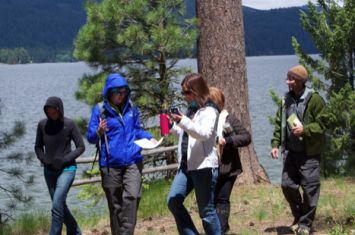 [6]
[6]Image 1: Teachers moving to the next checkpoint with their thermos of hot water and pine needles.
Provide the background
Current research is often steeped in years of previous research or involves more foundational concepts. Discovering the history behind current research can help explain and enrich the conversation on the current topic and current research can be a meaningful reason to teach the foundational science concepts it is built upon. With the example of NARA, educators can choose how deep to go into the background to explain the current research. For instance, lessons about biofuel can necessitate learning about renewable energy and various forms of renewable energy including, but not limited to, solar, wind, geothermal, or hydropower. Math and social studies lessons can be brought in to explain why we as a nation, or even a region, have moved from one choice to another. Students can analyze data to explain why one energy choice may benefit one region versus another.
The topic of biofuels can provide many sources of lessons as researchers have explored using corn, algae, grasses, and now trees for sources of energy. Chemistry lessons can explain the difference between ethanol and isobutanol fuels from a molecular level. This level of examination leads into the next process, breaking down the parts.
Example lesson: Toil for Oil
To introduce the background behind the need for renewable sources of fuel, a lesson called Toil for Oil was created by Facing the Future. Facing the Future is an independent program of Western Washington University that creates curriculum for educators that equip and motivate students to develop critical thinking skills, build global awareness, and engage in positive solutions for a sustainable future. In the lesson, students simulate oil extraction using a container filled with black and red beans. Students are tasked with removing the black beans (oil) from the red beans (soil/earth) in a limited time frame to see how much oil they can harvest. This is repeated for several rounds, resulting in less and less oil extraction per the limited time frame. Students then graph and analyze the amount of oil extracted in each round, which leads into a discussion about the distinguishing characteristics of nonrenewable and renewable resources.
Break down the parts
In using current research to create lessons, it’s necessary to break down the parts of the research. It may be that some aspects of the research are above the target audience level and can be abbreviated to simplify the concepts. For example, the NARA project is comprised of several steps, or “parts”: forest residuals preparation, transportation, pre treatment, enzymatic hydrolysis, fermentation, and bio jet and co-products. These parts of the NARA project are what leads to the end goal of producing bio jet fuel. Each one of the steps involves chemistry, logistics, and concepts that are often outside of the scope of many education goals. By breaking down the parts and the concepts within them lessons can be created for any audience to benefit from.
Example lesson: Woody peanut butter
One challenging aspect within the NARA project is to separate the woody waste from the usable cellulose and hemicellulose, the parts used to create the bio jet fuel, from the lignin co-product. In order to break down this chemistry, a creative lesson was designed to use with 5th and 6th graders to make the challenges more palatable. Students are challenged with separating the peanut butter that has been slathered over a sugar cube. Students are given a toothpick and paper towel as tools and instructed to put their sugar cube in a cup of hot water when they are completed. Whoever has the least murky solution is considered to have the cleanest fuel source. This hands-on activity introduces the challenges of separating out the parts within wood to get to what is useable for fuel. Although the chemistry involved is far beyond a 5th or 6th grade level, this fun, hands-on lesson can help students understand the basic challenges scientists currently face in the development of biofuels from wood. The photo below, image 3, shows teachers working on the challenge at a MOSS teacher workshop.
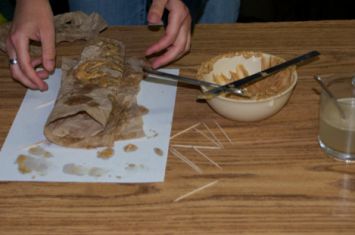 [8]
[8]Image 3: The messy business of separating out the useful materials from the co-products, in this case sugar and peanut butter
Draw the parallels
Often current research forages into new territory that is hard to summarize to the general population. Educators can link the concepts within the research by drawing parallels to student experience. Is there something in the research that can be related to something else you’re student population will understand? This concept relies on the previous steps of having explained the background and breaking down the parts. Within the steps and processes of the research and utilizing the background of the research there can be aspects that relate to more tangible concepts. For example, within NARA, one of the tasks is to understand and define the life cycle of bio jet fuel. Life cycle assessment (LCA) refers to the energy and costs associated with a product from start to finish, either to production, consumer, or to its end use (grave). LCA is a “compilation and evaluation of the inputs, outputs and the potential environmental impacts of a product system throughout its life cycle” (International Organization for Standardization). An LCA of a cup of coffee is a way to talk about all the energy and costs associated with producing a cup of coffee without getting into the complexities associated with bio jet fuel. Students can brainstorm and work through what it takes to grow the coffee beans, harvest them, prepare them for export, transport, distribute, and prepare for making a latte. Most adults can relate to the value of a cup of coffee, but may have not considered all the energy associated with getting those beans to their home or local coffee shop. An LCA of a cup of hot chocolate is an option more relatable for a younger population. By drawing parallels students can then relate to all the energy and costs associated with producing bio jet fuel.
Putting it all together
As mentioned earlier, these steps can be followed in any order to create a lesson from each step or to create one lesson incorporating all the steps.
Example lesson: Value of a tree
One lesson developed and used at MOSS, The Value of a Tree (Schon, Hougham, Eitel, & Hollenhorst, 2014) has been used with students ranging from 5th grade through 12th grade and with teachers. The lesson defines the theme behind the research, provides many opportunities to delve into the background around NARA to get students, of various ages, up to speed on the topic, and it breaks down an aspect of the science within the research. The lesson has students calculate how much carbon is in a tree and how far they could fly with this tree using the leftover woody biomass if the tree were harvested.
As students calculate the height of the tree, the diameter, and the age, they work through conversations about climate change, renewable energy, and utilizing resources. These topics themselves can provide weeks of lessons depending on how in-depth educators want to or need to get into with their students. In the end, students understand the complexities of the topic with enough background information to move forward into deeper levels within this research topic. The complete lesson can be found both on the MOSS Adventure Learning website (http://adventurelearningat.com/for-teachers/ [9]) and on the National Science Teacher Association, Science Scope website along with an article further explaining the lesson (http://www.nsta.org/middleschool/ [10]).
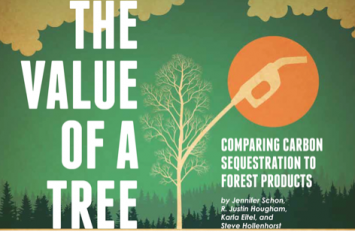 [11]
[11]Image 4: National Science Teacher Association Science Scope article: The Value of a Tree article, March 2014
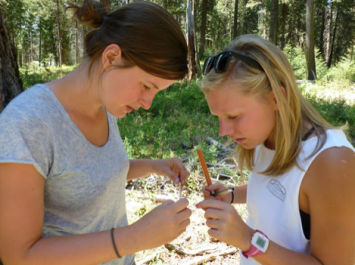 [12]
[12]Image 5: Graduate students at MOSS learning how to count the age of a tree from an increment borer.
Conclusion
Creating effective, interesting, and up-to date lessons can take time and energy educators often lack. Yet, with direct measures and steps, educators can easily incorporate current research into their curriculum. Often times applying new findings and progress in science can be daunting and unfamiliar as textbooks provide little assistance. Examples others have used and some guidance can often provide the spark needed to light educators creativity in designing interesting and informative lessons. By defining the theme of the research, providing basic or in-depth background knowledge, breaking down the parts and/or drawing the parallels, educators can bring research into the classroom, bridging the gap from current scientific efforts to on the ground teaching.
References
Edelson, D. C. (1998). Realising authentic science learning through the adaptation of
scientific practice. International handbook of science education,1, 317-331.
Haine, D. & Kloda, M. (2014) Bringing current science into the classroom. Learn NC.
retrieved from http://www.learnnc.org/lp/editions/superfund/754 [13] on July 31st 2014.
Hendrickson, D., Shaw, D., Jacob, S., Keefe, A., & Skelton, L. 2014. Fueling our Future: Exploring Sustainable Energy Use. (Middle School ed.). Seattle: Facing the Future.
Hendrickson, D., Shaw, D., Jacob, S., Keefe, A., & Skelton, L. 2014. Fueling Our Future: Exploring Sustainable Energy Use. (High School ed.). Seattle: Facing the Future.
Hougham, R. J., Schon, J.A., Bradley Eitel, K., & Hollenhorst, S.A. (2012). Education at the Speed of Research: Communicating the Science of Biofuels. Published Proceedings of the Sun Grant Initiative. New Orleans, LA.
International Organization for Standardization (1997). Environmental Management:
Life Cycle Assessment – Principles and framework, 14040.
Laursen, S., Liston, C., Thiry, H., & Graf, J. (2007). What good is a scientist in the
classroom? Participant outcomes and program design features for a short-duration science outreach intervention in K–12 classrooms. CBE-Life Sciences Education, 6(1), 49-64.
Lee, H-S., Butler, N. (2010). Making authentic science accessible to students.
International Journal of Science Education. 25: 8, 923-948.
Schon, J., Hougham, R.J., Eitel, K., & Hollenhorst, S. (2014). The value of a tree:
comparing carbon sequestration to forest products. Science Scope, 37:7, 27-35.
Scientific American (2014). What is Citizen Science? Scientific American. Retrieved
from http://www.scientificamerican.com/citizen-science/ [3].
Selvakumar, M. (2014). Portal to the Public. Informal Science. Retrieved from
http://informalscience.org/perspectives/blog/portal-to-the-public/ [4].
Solar Impulse, sun-powered place, completes test flight above San Francisco bay area.
(2013, April 19). Huffington Post. Retrieved from http://www.huffingtonpost.com/2013/04/19/solar-impulse-plane_n_3118560.html [14]
Acknowledgments
This work, as part of the Northwest Advanced Renewables Alliance (NARA), was supported by the Agriculture and Food Research Initiative Competitive Grant no. 2011-68005-30416 from the USDA National Institute of Food and Agriculture.
We’d like to express our appreciation to the MOSS graduate students whose helped create and test lessons, teachers attending our Professional Training workshop summer 2014, and all the NARA members who’s work and dedication has made this research possible.
